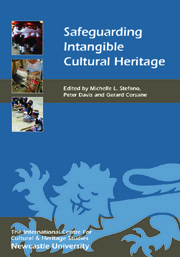Book contents
- Frontmatter
- Contents
- List of Illustrations
- Acknowledgments
- Touching the Intangible: An Introduction
- NEGOTIATING AND VALUING THE INTANGIBLE
- APPLYING THE INTANGIBLE CULTURAL HERITAGE CONCEPT
- ON THE GROUND: SAFEGUARDING THE INTANGIBLE
- 14 Acquiring the Tools for Safeguarding Intangible Heritage: Lessons from an ICH Field School in Lamphun, Thailand
- 15 Intangible Threads: Curating the Living Heritage of Dayak Ikat Weaving
- 16 Conversation Piece: Intangible Cultural Heritage in South Africa
- 17 Revitalising Amerindian Intangible Cultural Heritage in Guyana and its Value for Sustainable Tourism
- 18 When ICH Takes Hold of the Local Reality in Brazil: Notes from the Brazilian State of Pernambuco
- 19 Reconfiguring the Framework: Adopting an Ecomuseological Approach for Safeguarding Intangible Cultural Heritage
- 20 Conversation Piece: Intangible Cultural Heritage in Italy
- 21 Looking to the Future: The en-compass Project as a Way Forward for Safeguarding Intangible Cultural Heritage
- List of Contributors
- Index
21 - Looking to the Future: The en-compass Project as a Way Forward for Safeguarding Intangible Cultural Heritage
from ON THE GROUND: SAFEGUARDING THE INTANGIBLE
Published online by Cambridge University Press: 05 February 2013
- Frontmatter
- Contents
- List of Illustrations
- Acknowledgments
- Touching the Intangible: An Introduction
- NEGOTIATING AND VALUING THE INTANGIBLE
- APPLYING THE INTANGIBLE CULTURAL HERITAGE CONCEPT
- ON THE GROUND: SAFEGUARDING THE INTANGIBLE
- 14 Acquiring the Tools for Safeguarding Intangible Heritage: Lessons from an ICH Field School in Lamphun, Thailand
- 15 Intangible Threads: Curating the Living Heritage of Dayak Ikat Weaving
- 16 Conversation Piece: Intangible Cultural Heritage in South Africa
- 17 Revitalising Amerindian Intangible Cultural Heritage in Guyana and its Value for Sustainable Tourism
- 18 When ICH Takes Hold of the Local Reality in Brazil: Notes from the Brazilian State of Pernambuco
- 19 Reconfiguring the Framework: Adopting an Ecomuseological Approach for Safeguarding Intangible Cultural Heritage
- 20 Conversation Piece: Intangible Cultural Heritage in Italy
- 21 Looking to the Future: The en-compass Project as a Way Forward for Safeguarding Intangible Cultural Heritage
- List of Contributors
- Index
Summary
INTRODUCTION
The value of Intangible Cultural Heritage (ICH) resources, as defined in the Introduction to this volume, has been receiving increasing recognition internationally during the last few decades. This is in large part due to the recent work that has been undertaken by UNESCO before and after the adoption of the Convention for the Safeguarding of Intangible Cultural Heritage (UNESCO 2003) at the 32nd session of its General Conference in 2003. The Convention entered into force on 20 April 2006 after the terms of Article 34 within it had been met and 30 States had ratified it by 20 January of that year. Since then the recognition and interest of ICH has continued to escalate and, by January 2012, 142 States Parties have deposited their respective instruments of ratification, acceptance, approval or accession to UNESCO (UNESCO 2012a). Furthermore, within these countries, organisations and bodies at a number of levels have conducted work and developed programmes and projects to document, safeguard and promote ICH resources. These actions have become crucial, with so many ICH resources, traditional practices and cultural expressions being under threat from phenomena such as industrialisation, modernisation, urbanisation and globalisation. With the ongoing loss of these resources, practices and expressions, there is the need for practical and sustainable ways to safeguard these valuable aspects of heritage as forms of social, cultural and identity capital.
- Type
- Chapter
- Information
- Safeguarding Intangible Cultural Heritage , pp. 247 - 262Publisher: Boydell & BrewerPrint publication year: 2012



